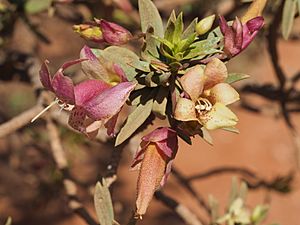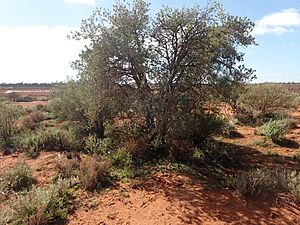Kopi poverty bush facts for kids
Quick facts for kids Kopi poverty bush |
|
|---|---|
 |
|
| Eremophila miniata leaves and flowers | |
| Scientific classification | |
| Genus: |
Eremophila (plant)
|
| Species: |
miniata
|
The kopi poverty bush (scientific name: Eremophila miniata) is a cool flowering plant found only in Western Australia. People also call it "plumridge." This plant belongs to the figwort family, which is known as Scrophulariaceae.
It's a type of shrub that grows straight up. It has lots of tangled branches, greyish leaves, and flowers that can be different colors. You might see its flowers in shades of red, yellow, or cream.
Contents
What Does Kopi Poverty Bush Look Like?
The kopi poverty bush is a shrub or small tree. It usually grows to be about 1.5 to 5 meters (5 to 16 feet) tall. It has thick, tangled branches that can break easily. You'll notice raised marks on the branches where leaves used to be.
Its leaves are often grouped together at the ends of the branches. They are thick and shaped like narrow spears. They can feel a bit sticky and are usually about 2 to 4 centimeters (0.8 to 1.6 inches) long and 3 to 8 millimeters (0.1 to 0.3 inches) wide.
Flowers and Fruit
The flowers grow one by one where the leaves meet the stem. Each flower sits on a hairy stalk that is about 1 to 3 centimeters (0.4 to 1.2 inches) long.
Each flower has five colorful, overlapping sepals. Sepals are like small leaves that protect the flower bud. These sepals are usually 1.4 to 2 centimeters (0.6 to 0.8 inches) long. They can be green, yellow, orange, or even purplish-red.
The petals of the flower are 2.5 to 4 centimeters (1 to 1.6 inches) long. They join together at the bottom to form a tube shape. The outside of the petals can be orange-red, yellow, or cream. The inside is yellow, sometimes with raised red or orange spots. Both the petal tube and its parts are hairy, inside and out.
There are four stamens (the parts that make pollen) that stick out beyond the end of the petal tube. This plant usually flowers from July to December. After the flowers, dry, oval-shaped fruits grow. They have a pointed end, a papery covering, and are smooth. Each fruit is about 9 millimeters (0.4 inches) long.

Where Does Kopi Poverty Bush Grow?
You can find the kopi poverty bush in many parts of Western Australia. It grows in areas between Kalgoorlie and Cue.
It likes to grow on sandy hills or in flat, clay areas near salt lakes and places where water flows. This plant is quite tough and can handle different types of environments.
Growing Kopi Poverty Bush in Your Garden
If you have a big garden, planting two different color forms of this plant together can look really nice. A cool thing about this plant is that its colorful sepals often stay on the plant much longer than the petals do.
You can grow new kopi poverty bush plants from cuttings. However, in cooler places, it's often more successful to join a piece of the kopi poverty bush onto another plant's rootstock (like a Myoporum plant). This is called grafting.
This large shrub or small tree is very strong and can grow in most types of soil, even clay. It prefers to be in full sun. In nature, it sometimes gets flooded, and in a garden, it can handle dry periods. But it also likes to be watered well sometimes. It can also handle a bit of frost.

